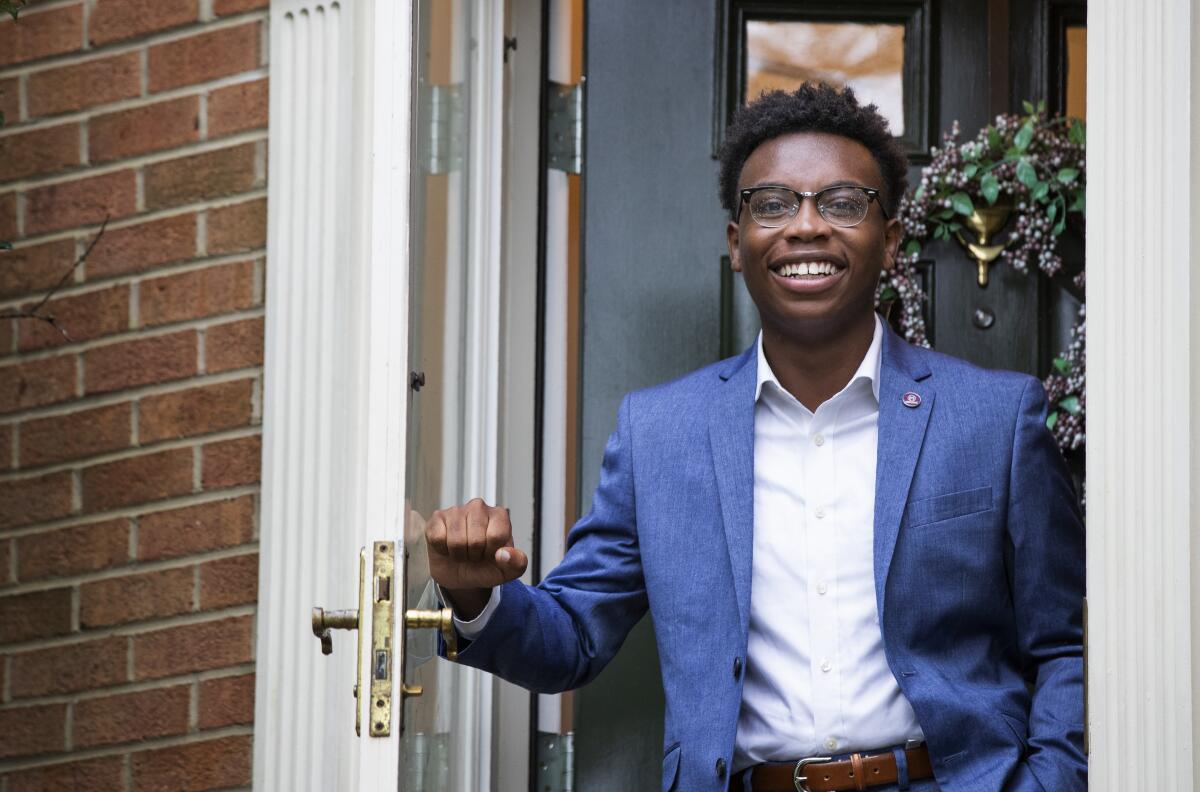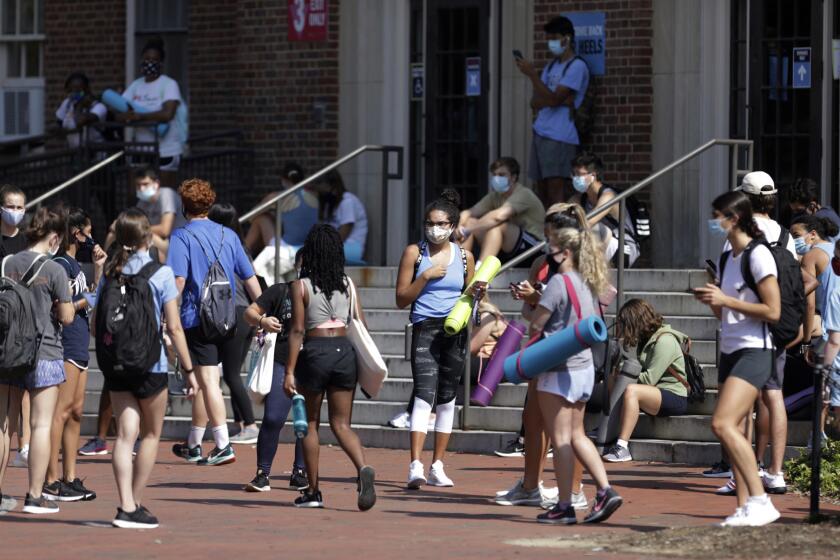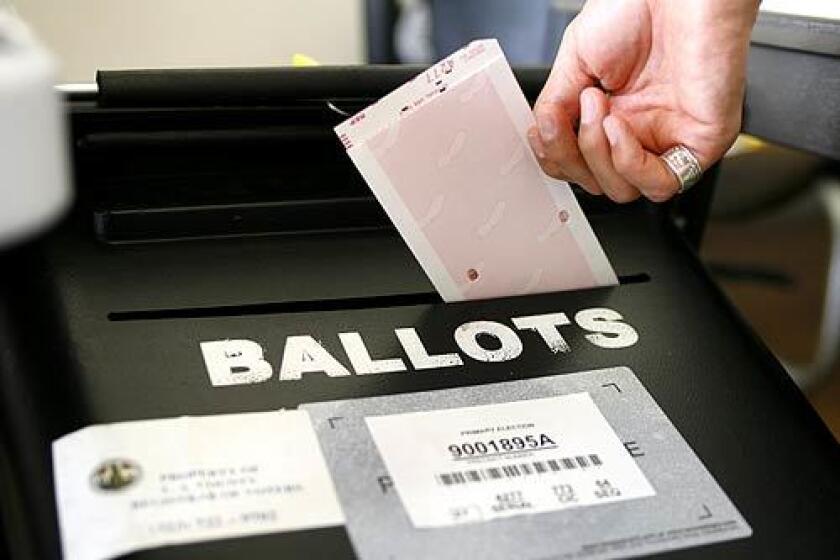Campaigns, voting groups scramble to reach college students amid coronavirus

- Share via
RALEIGH, N.C. — Chase Gaines wishes he could get more young people in North Carolina to answer their front doors and take his GOP flyer.
Rick Hart longs for the days where he would wake up at 6 a.m. to prep for a day of campaigning in the streets of Atlanta to persuade his classmates to elect Democrats.
The two college students are on opposite ends of the political spectrum but face the same challenge: reaching young voters when campuses are empty and students are scattered across the country.
“The pandemic really did hit us significantly,” said Hart, an unpaid student volunteer at Morehouse College who was working in Georgia on behalf of Democratic presidential nominee Joe Biden but who is now back at his parents’ home in Laurel, Md. “The country kind of came to a shutdown and we were like, ‘What do we do next?’”
Campaigns, advocacy groups and registration organizations say they’re still struggling to answer that question — and looking for creative, largely digital solutions.
The coronavirus has forced many colleges to adopt online-only classes, eliminating hopes of large in-person registration drives on campus. Outdoor festivals, sporting events and other public gatherings are canceled, cutting off more routes of easy access to college-age voters.
Colleges should anticipate students will gather because they are affected by loneliness and social isolation, made worse by COVID-19 restrictions.
Groups dedicated to rallying young voters have worries that go beyond registrations. With campuses closing, college students are especially transient, causing confusion about whether they should register at their home or school address. The shift to mail voting raises other unexpected hurdles for young voters, including a lack of familiarity with the U.S. Postal Service and even improper cursive penmanship that can lead to rejected votes.
“Younger voters are behind the eight ball to begin with, and COVID is just going to make it worse,” said Daniel Smith, a professor and chair of political science at the University of Florida, who has studied mail-in balloting.
All of these worries are a bigger headache for Democrats, who are more dependent on college voters’ support and, in a traditional campaign, their volunteerism. Voters under 30 made up 13% of the electorate in 2016, according to an analysis by Pew Research Center. This year, polls show that the age group favors Biden by a wide margin. And if they vote, they could also play an important role in Senate, House and down-ballot contests.
But traditional outreach to college voters has been upended. There are no tables set up in many student unions or young people carrying clipboards at concerts and rallies, said Patrick Schuh, Michigan state director for America Votes, which supports Democratic candidates and progressive causes.
Looking at the numbers can give parents a sense of how the county is doing in containing the coronavirus and help them make a difficult decision.
“All of these visibility events are important. They show energy; they help with engagement,” Schuh said.
The Democratic National Committee and Biden’s campaign have greatly restricted staff travel, effectively eliminating coordinated in-person voter contacts. The advocacy group NextGen America, which was founded by former Democratic presidential candidate Tom Steyer to increase youth participation, said it doesn’t have paid staff members on college campuses.
The initial impact was clear. In North Carolina, which President Trump won in 2016 and Democrats are hoping to flip, registrations among young people between 18 and 29 dropped sharply when the coronavirus forced campus closures in March. That has begun to rebound.
Kate Fellman, executive director of the nonpartisan voter registration group You Can Vote, said the organization set a goal this year to register 30,000 people, 18 to 25, in the state. She said the team had 4,391 new registrants before the pandemic hit in mid-March. But in the four months since, the group registered just dozens of people.
Get our L.A. Times Politics newsletter
The latest news, analysis and insights from our politics team.
You may occasionally receive promotional content from the Los Angeles Times.
Making up for that lost ground has meant getting creative. Individual students are turning to social media platforms to persuade young people to register to vote. NextGen is sifting through Twitter to find potential voters and is directly messaging them. Some groups and campaigns have gone old-school, ramping up phone banking efforts and noting an increased rate of responses from young people stuck at home.
There are signs that college-age people are strongly motivated to participate in the election.
Of the 39 states for which it had reliable data, the Center for Information & Research on Civic Learning and Engagement found a majority of the states already have a higher number of young people now registered to vote in 2020 compared with November 2016.
As for battleground states, the number of registrants between ages 18 and 24 in Georgia is 28% higher than it was in November 2016. Registration is also up by 13% in Texas, 10% in Arizona and 7% in Michigan, but it is down in Ohio by 17% and 10% in Pennsylvania over the same period of time. Nevada, Florida and North Carolina have about the same number of young registered voters as before the 2016 presidential election.
In 2018, a number of colleges and universities joined together to increase student voting. It worked.
Republican campaigns have been more willing to conduct outreach in person. Trump campaign spokeswoman Samantha Zager said the campaign has 73 target campuses and more than 550 students working to assist with recruitment, training and activation on campus and online.
“Our youth engagement efforts will continue both virtually and in person,” she added.
Symone Sanders, senior campaign advisor for Biden, oversees a program that includes more than 300 chapters. The campaign said it will have hired staff members dedicated to campus voting in more than 10 battleground states by the end of August.
But registering college students to vote is just half the battle.
States set their own elections procedures and have different policies for in-person and mail-in voting. A student who registers to vote using a campus address could see dormitories or other campus housing shut down because of an outbreak before being able to vote. Voting by mail also has its challenges, with studies showing young voters are more likely than voters of other age groups to have their mail-in ballots rejected.
More to Read
Get the L.A. Times Politics newsletter
Deeply reported insights into legislation, politics and policy from Sacramento, Washington and beyond. In your inbox three times per week.
You may occasionally receive promotional content from the Los Angeles Times.













